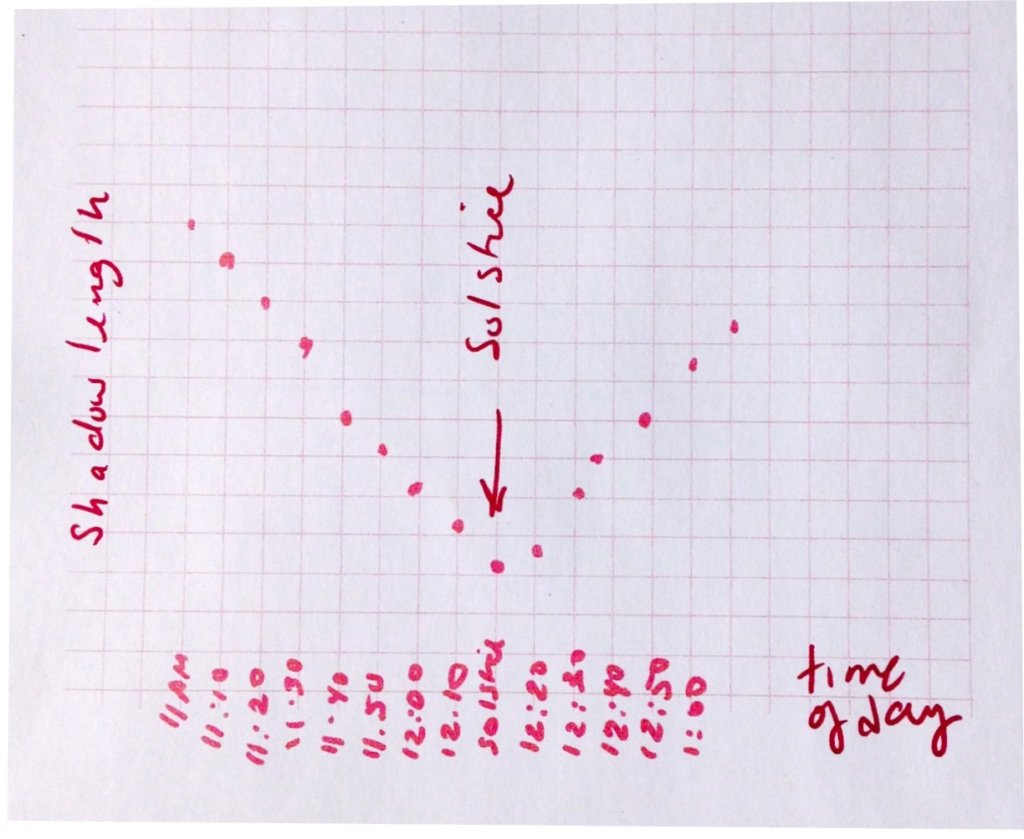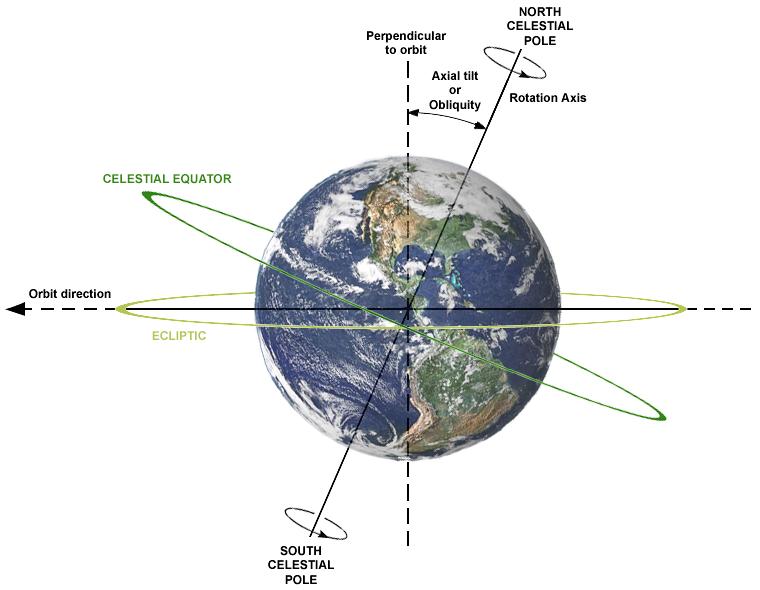Once upon a time, about 4.5 billion years ago, back when Earth was just a baby planet, our young solar system was a dangerous neighborhood, with all sorts of space debris zipping back and forth. And it was then that an object roughly the size of Mars rudely smacked into Earth. The force melted Earth’s surface, the heavier elements of the errant object fused with Earth, and enough additional debris spattered into space to eventually coalesce into our Moon.
Without that cataclysmic event, “Season’s Greetings” would be replaced by just “Greetings!”
It was also that cosmic smack that gave Earth its tilt of 23.44 degrees. And that tilt gives us our seasons and seasonal changes in day length. Without that cataclysmic event, we wouldn’t have Spring Break, Summer Vacation, or Octoberfest. “Season’s Greetings” would be replaced by just “Greetings!” And how boring would that be?
But why take my word for it that Earth has a tilt! You can measure it yourself at noon on December 20, the winter solstice! All you need is a stick-like object (like a stick), a tape measure and two web links. This one will tell you your latitude:
And this one will give you painful flashbacks to high school math class, where you failed to fully understand sine, cosine, tangent, arctan and all that trigonometry stuff, but, despite that, will also let you painlessly derive the angle of Earth’s tilt, just like a toga-clad, sandals-wearing Greek scholar:
https://www.rapidtables.com/calc/math/Arctan_Calculator.htm
Quick and Easy Way to Measure Earth’s Tilt
Stuff you’ll need:
A stick-like object (for example, a stick; a ruler; a meter stick; a broom handle) to stick into the ground.
Tape measure or ruler/meter stick for measuring (not the same ruler/meter stick you’re sticking into the ground)
Pen/Pencil/Crayon/stylus and paper/clay tablet (to record your data)
Your latitude: Calculate your latitude!
An Arctangent calculator, like this one: https://www.rapidtables.com/calc/math/Arctan_Calculator.htm
A regular calculator, like the one on your phone, for basic calculations
At Noon on the Solstice:
(1) Gather your materials so that you’re ready to go: a ruler, meter stick or anything else stick-like; a measuring tape; notebook and pen or other note-taking implements.
(2) Find out your latitude at https://www.latlong.net/ and write it down.
(3) Find some level ground and place the stick in the ground (or snow) so that the stick is vertical and so that you are able to measure the shadow that it casts. It’s important that the ground is level and that you are able to see the shadow for all of your measurements.
(4) Use your measuring tape to measure the length of the stick above the ground. Write down the length.
(5) Measure the length of the shadow of the stick.
(6) Using any calculator, calculate the following: (Stick Length)/(Shadow Length). So, Stick length, divided by Shadow Length.
(7) Take the resulting number and enter it into the Arctan calculator: https://www.rapidtables.com/calc/math/Arctan_Calculator.htm The result is the Sun’s Angle, expressed in degrees.
(8) Subtract this number from your latitude: (Your Latitude) – (Sun’s Angle) = Earth’s Tilt
(9) Tada!
In our original Science Update story (below), NASA physicist Betsy Pugel explained it all to us, and shared her instructions for Solstice Day Fun.
Earth’s Tilt
Sizing up earth’s tilt. I’m Bob Hirshon and this is Science Update.
The earth tilts about 23.4 degrees—in the summer months, the north pole is tilted toward the sun, giving us more daylight and warmth, and in the winter, it’s tilted away. Tyler from Missouri emailed us to ask how scientists know that angle. NASA Physicist Betsy Pugel says that if you’re willing to wait until noon at the winter solstice—that’s December 21st—you can measure it yourself by standing a ruler outside on the ground.
BETSY PUGEL (NASA):
Just take the length of the ruler, divide it by the length of the shadow, and then go into a calculator and calculate the inverse tangent and it will give you what that angle is. And so that angle is related to the tilt of the earth where you are.
HIRSHON:
She adds that thousands of years ago, people worked out the tilt in much the same way, but without the calculator. I’m Bob Hirshon for AAAS, the Science Society.
————————————————————————————————————————————————————-
CALCULATE EARTH’S TILT ON DECEMBER 21st USING BETSY PUGEL’S HANDY EARTH TILT CALCULATOR!
Why take other people’s word for it that Earth has a tilt? Measure it for yourself on December 21st!
Stuff you’ll need:
A stick-like object (for example, a stick; a ruler; a meter stick; a broom handle) to stick into the ground.
Tape measure or ruler/meter stick for measuring (not the same ruler/meter stick you’re sticking into the ground)
Pen/Pencil/Crayon/stylus and paper/clay tablet (to record your data)
Graph paper: Print your own graph paper!
Your latitude: Calculate your latitude!
An Arctangent calculator, like this one: https://www.rapidtables.com/calc/math/Arctan_Calculator.htm
A regular calculator, like the one on your phone, for basic calculations
Note: This will not work if it is a cloudy day.
Note #2: This method works in places that are north of the “Tropic of Cancer,” which includes the Continental U.S. and Canada, Europe, most of Asia and the northernmost part of Africa.
Two approaches:
(1) The Quick and Easy Version, which will take about 10 minutes max; you do it right at noon on December 21st.
(2) Winter Solstice Tilt Measurement, The Extended Remix, takes a few hours, but makes you feel like a boss (science-style). You start at about 11 am on December 21st.
Directions:
(1) Gather your materials so that you’re ready to go: a ruler, meter stick or anything else stick-like; a measuring tape; notebook and pen or other note-taking implements.
(2) Find out your latitude at https://www.latlong.net/ and write it down.
(3) Find some level ground and place the stick in the ground (or snow) so that the stick is vertical and so that you are able to measure the shadow that it casts. It’s important that the ground is level and that you are able to see the shadow for all of your measurements.
(4) Use your measuring tape to measure the length of the stick above the ground. Write down the length.
(5) Note the time and write that on your piece of paper.
(6) Measure the length of the shadow of the stick.
(7) If you are doing The Quick and Dirty Version, jump to the end of the instructions, where it says How do I calculate tilt?
(8) If you are doing The Extended Remix, you’ll need to note the time and the length of the shadow every 10 minutes starting at 11 am and going until 1 pm. You will end up with 6 data points in the first hour: a point at noon; and 6 data points after noon. In this version, you’ll be looking for the shortest shadow, rather than just using noon, since noon is only an approximation. And that’s not good enough for you.
Extended Remix Version:
(1) If you do (8) as instructed, you will be able to plot the length of the shadow versus time using the graph paper
(2) The graph should look something like this:

How Do I Calculate Tilt?
You’ll need:
https://www.rapidtables.com/calc/math/Arctan_Calculator.htm
For the Quick and Dirty Version:
(1) Using any calculator, calculate the following: (Stick Length)/(Shadow Length). So, Stick length, divided by Shadow Length.
(2) Take the resulting number and enter it into the Arctan calculator: https://www.rapidtables.com/calc/math/Arctan_Calculator.htm The result is the Sun’s Angle, expressed in degrees.
(3) Subtract this number from your latitude: (Your Latitude) – (Sun’s Angle) = Earth’s Tilt
(4) Tada!
For the Extended Remix
(1) Select the shadow length at the solstice. It should be when the shadow of the stick is the shortest
(2) Using any calculator, calculate the following: (Stick Length)/(Shadow Length). So, Stick Length, divided by Shadow Length.
(3) Take the resulting number and enter it into the Arctan calculator: https://www.rapidtables.com/calc/math/Arctan_Calculator.htm The result is the Sun’s Angle, expressed in degrees.
(4) Subtract this number from your latitude: (Your Latitude) – (Sun’s Angle) = Earth’s Tilt
(5) Tada!


 NASA Announces Historic Cat Video Transmission
NASA Announces Historic Cat Video Transmission